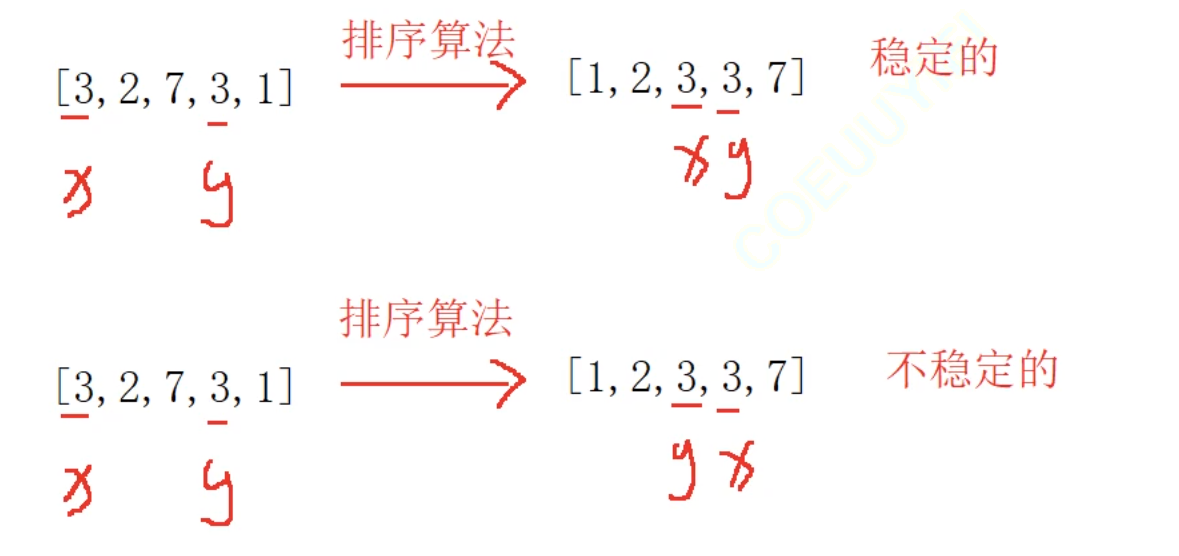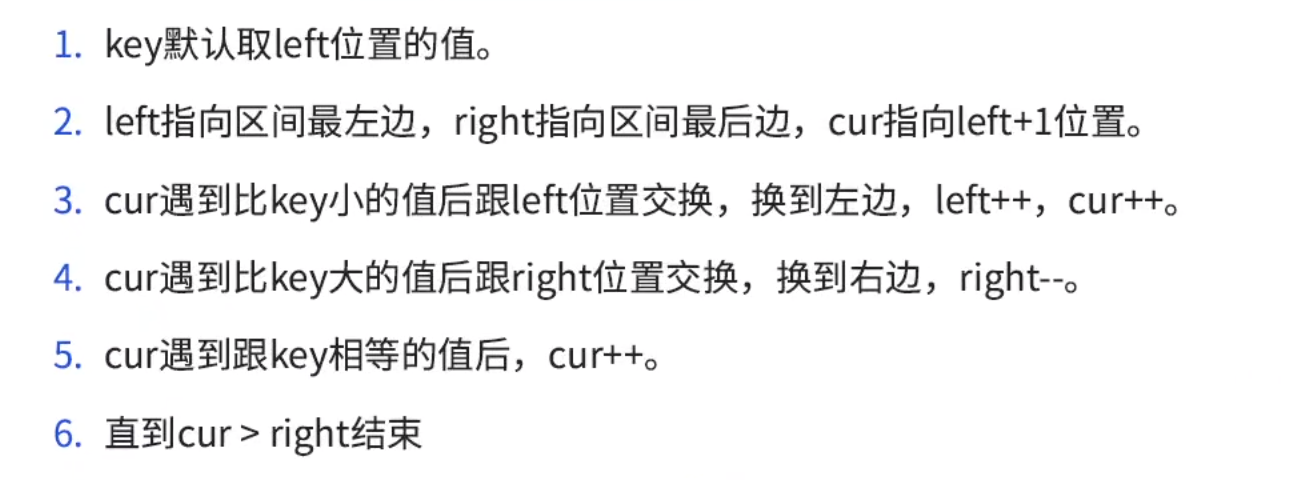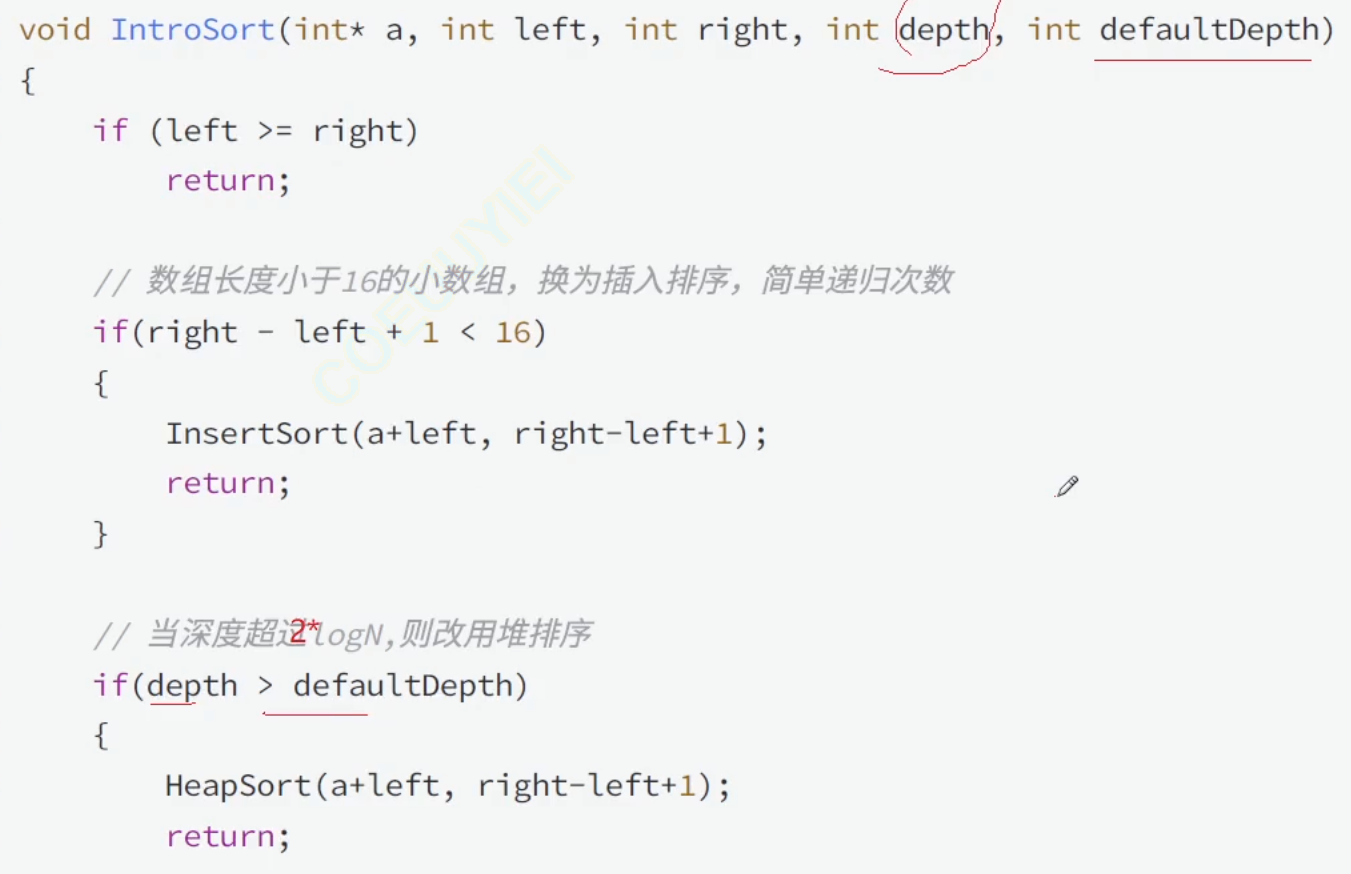一、计数排序
计数排序又称为鸽巢原理,是对哈希直接定址法的变形应用。操作步骤如下:①统计相同元素出现的次数 ②根据统计的结果将序列回收到原来的序列中
比如,现在有一个数组{6,1,2,9,4,2,4,1,4}。该数组中,元素1出现两次,元素2出现两次,元素4出现三次,元素6出现一次,元素9出现一次。我们这时就可以创建一个新数组,把原数组里的数据作为新数组的下标,原数组数据出现的次数作为新数组里下标对应的值,得到的新数组如下图所示:

这时我们定义一个变量 i 遍历 count 数组,如果count[i] 里的数据不为0,我们就循环向arr数组中插入count[i] 次,就可以得到排好序的数组,如下图所示:

思路很简单,但是新创建的count数组的大小如何确定呢?
在上面的示例中,我们似乎是找到了原数组中的最大值9,然后给count数组开辟了0~9共10个空间,那么是不是这样开辟空间大小就行呢?假如现在有一个数组{100,101,109,105,101,105},如果我们还像刚才那样开辟0~109共110个空间,那么count数组中下标为0~99这100个空间就严重浪费了。所以原数组中找最大值,再让最大值+1这个方法是错误的,可能会造成空间浪费。那该怎么做呢?我们还拿{100,101,109,105,101,105}这个数组为例,最大值max = 109,最小值min =100,100~109之间最多有10个数据,也就是说count数组所需的最大空间就是10,所以我们用max - min + 1就可以得到count数组的空间大小了。
注:计数排序在数据范围集中时效率很高,但是适用范围及场景有限!
代码如下:
//计数排序
void CountSort(int* arr, int n)
{
//找最大和最小值
int min = arr[0], max = arr[0];
for (int i = 1;i < n;i++)
{
if (arr[i] < min)
{
min = arr[i];
}
if (arr[i] > max)
{
max = arr[i];
}
}
// max - min + 1 确定count数组大小
int range = max - min + 1;
int* count = (int*)malloc(range * sizeof(int));
if (count == NULL)
{
perror("malloc fail");
exit(1);
}
//初始化
memset(count, 0, range * sizeof(int));
for (int i = 0;i < n;i++)
{
count[arr[i] - min]++;
}
//将count数组还原到原数组中,使其有序
int index = 0;
for (int i = 0;i < range;i++)
{
while (count[i]--)
{
arr[index++] = min + i;
}
}
}计数排序时间复杂度为O(N + range)
稳定性:稳定
二、排序算法的稳定性分析
稳定性:假设在待排序的序列中,存在多个具有相同关键字的记录,经过排序,这些记录的相对次序保持不变。即在原序列中,r[i] == r[j],且r[i] 在 r[j] 之前,而排序后的序列,r[i] 仍在 r[j] 之前,则称这种排序算法是稳定的。

下面给出七种排序算法的时间复杂度和稳定性:
| 排序方法 | 时间复杂度 | 稳定性 |
| 冒泡排序 | O(n^2) | 稳定 |
| 直接选择排序 | O(n^2) | 不稳定 |
| 直接插入排序 | O(n^2) | 稳定 |
| 希尔排序 | O(nlogn)~O(n^2) | 不稳定 |
| 堆排序 | O(nlogn) | 不稳定 |
| 归并排序 | O(nlogn) | 稳定 |
| 快速排序 | O(nlogn) | 不稳定 |
三、快速排序 拓展
快速排序最核心的一点在于基准值的确定。关于如何找基准值,我们在上一章讲了三种方法。但是,当待排序数组中含有大量重复数据时,再使用之前的方法会让快速排序的时间复杂度接近于O(n^2)。因此,这里分享两种优化方法。
1、三路划分
三路划分,顾名思义,就是把数组划分成三个区间。把重复的相等的数据集中在中间,左边就是较小值,右边就是较大值。方法如下图所示:

根据上述的方法思路,我们来模拟实现一下该流程:







单次循环划分完毕之后,只需对左右两块区间递归即可。
void QuickSort(int* arr, int left, int right)
{
if(left >= right)
{
return;
}
int begin = left;
int end = right;
int key = arr[left];
int cur = left + 1;
while(cur <= right)
{
if(arr[cur] < key)
{
Swap(&arr[cur], &arr[left]);
cur++;
left++;
}
else if(arr[cur] > key)
{
Swap(&arr[cur], &arr[right]);
right--;
}
else
{
cur++;
}
}
//[begin, left-1] [left, right] [right+1, end]
QuickSort(arr, begin, left - 1);
QuickSort(arr, right + 1, end);
}2、自省排序(introsort)
introsort是introspective sort的缩写,顾名思义,该方法的思路就是进行自我的侦测与反省,快排递归深度太深(sgi STL中使用的是深度为2倍排序元素数量的对数值)那就说明在这种数据序列下,选key出现了问题,性能在快速退化,那么就不要再进行快排分割递归了,改换为堆排序进行排序。
了解即可,不做代码要求。

四、归并排序 拓展
1、非递归版本归并排序

//非递归版本归并排序
void MergeSortNonR(int* arr, int n)
{
int* tmp = (int*)malloc(sizeof(int) * n);
if (tmp == NULL)
{
perror("malloc fail");
exit(1);
}
int gap = 1;
while (gap < n)
{
//根据gap划分组,两两一合并
for (int i = 0;i < n;i += 2 * gap)
{
int begin1 = i, end1 = i + gap - 1;
int begin2 = i + gap, end2 = i + gap + gap - 1;
if (begin2 >= n)
{
break;
}
if (end2 >= n)
{
end2 = n - 1;
}
int index = begin1;
//两个有序序列进行合并
while (begin1 <= end1 && begin2 <= end2)
{
if (arr[begin1] < arr[begin2])
{
tmp[index++] = arr[begin1++];
}
else
{
tmp[index++] = arr[begin2++];
}
}
while (begin1 <= end1)
{
tmp[index++] = arr[begin1++];
}
while (begin2 <= end2)
{
tmp[index++] = arr[begin2++];
}
//导入到原数组中
memcpy(arr + i, tmp + i, sizeof(int) * (end2 - i + 1));
}
gap *= 2;
}
}2、文件归并排序
2.1 外排序
外排序(External sorting)是指能够处理极大量数据的排序算法。通常来说,外排序处理的数据不能能一次装入内存,只能放在读写较慢的外存储器(通常是硬盘)上。外排序通常采用的是一种“排序---归并”的策略。在排序阶段,先读入能放在内存中的数据量,将其排序输出到一个临时文件,依次进行,将待排序数据组织为多个有序的临时文件。然后在归并阶段将这些临时文件组合为一个大的有序文件,即排序结果。
跟外排序对应的就是内排序,我们之间讲的常见的排序都是内排序。它们的排序思想适应的是数据在内存中,支持随机访问。归并排序的思想是不需要随机访问数据,只需要依次按序列读取数据,所以归并排序既是一个内排序,也是一个外排序。
2.2 思路分析

2.3 参考代码
#include <stdio.h>
#include <stdlib.h>
#include <time.h>
//创建N个随机数,写到文件中
void CreateNData()
{
//造数据
int n = 100000;
srand(time(0));
const char* file = "data.txt";
FILE* fin = fopen(file, "w");
if(fin == NULL)
{
perror("fopen fail");
return;
}
for(int i = 0;i < n;i++)
{
int x = rand() + i;
fprintf(fin, "%d\n", x);
}
fclose(fin);
}
int compare(const void* a, const void* b)
{
return (*(int*)a - *(int*)b);
}
//返回实际读到的数据个数,没有数据就返回0
int ReadNDataSortToFile(FILE* fout, int n, const char* file1)
{
FILE* fin = fopen(file1, "w");
if(fin == NULL)
{
perror("fopen fail");
return -1;
}
int x = 0;
int* arr = (int*)malloc(sizeof(int) * n);
if(arr == NULL)
{
perror("malloc fail");
return -1;
}
//读取n个数据,如果遇到文件结束,应该读j个
int j = 0;
for(int i = 0;i < n;i++)
{
if(fscanf(fout, "%d", &x) == EOF)
{
break;
}
arr[j++] = x;
}
if(j == 0)
{
return 0;
}
//排序
qsort(arr, j, sizeof(int), compare);
//写回file1文件
for(int i = 0;i < j;i++)
{
fprintf(fin, "%d\n", arr[i]);
}
fclose(fin);
return j;
}
void MergeFile(const char* file1, const char* file2, const char* mfile)
{
FILE* fout1 = fopen(file1, "r");
if(fout1 == NULL)
{
perror("fopen fail");
return;
}
FILE* fout2 = fopen(file2, "r");
if(fout2 == NULL)
{
perror("fopen fail");
return;
}
FILE* mfin = fopen(mfile, "r");
if(mfin == NULL)
{
perror("fopen fail");
return;
}
int x1 = 0;
int x2 = 0;
int ret1 = fscanf(fout1, "%d", &x1);
int ret2 = fscanf(fout2, "%d", &x2);
while(ret1 != EOF && ret2 != EOF)
{
if(x1 < x2)
{
fprintf(mfin, "%d\n", x1);
ret1 = fscanf(fout1, "%d", &x1);
}
else
{
fprintf(mfin, "%d\n", x2);
ret2 = fscanf(fout2, "%d", &x2);
}
}
while(ret1 != EOF)
{
fprintf(mfin, "%d\n", x1);
ret1 = fscanf(fout1, "%d", &x1);
}
while(ret2 != EOF)
{
fprintf(mfin, "%d\n", x2);
ret2 = fscanf(fout2, "%d", &x2);
}
}
int main()
{
CreateNData();
const char* file1 = "file1.txt";
const char* file2 = "file2.txt";
const char* mfile = "mfile.txt";
FILE* fout = fopen("data.txt", "r");
if(fout == NULL)
{
perror("fopen fail");
return;
}
ReadNDataSortToFile(fout, 100, file1);
ReadNDataSortToFile(fout, 100, file2);
while(1)
{
MergeFile(file1, file2, mfile);
//删除file1和file2
remove(file1);
remove(file2);
//重命名mfile为file1
rename(mfile, file1);
//当再次读取数据,一个都读不到,说明已经没有数据了
//已经归并完成,归并结果在file1
if(ReadNDataSortToFile(fout, 100, file2) == 0)
{
break;
}
}
return 0;
}